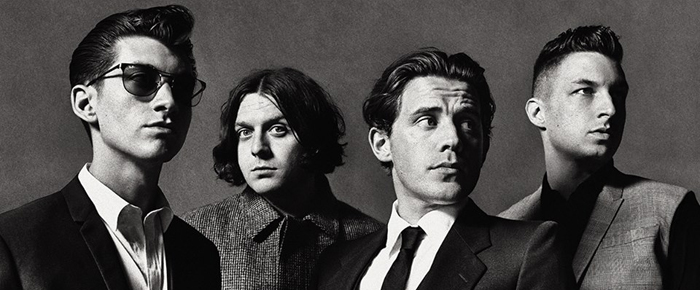
By Eleni P. Austin
When Arctic Monkeys burst on the scene in 2006, it was a blast of raw Punk power. At the beginning of the 21st century, bands like the Libertines, Franz Ferdinand, Clinic and Razorlight attempted to re-invigorate the comatose carcass of Punk Rock. But it was the Arctic Monkeys who succeeded in harnessing the combustible energy and snarling attitude first exhibited by the inaugural class of ’77.
In 2001, Alex Turner and Jamie Cook each received guitars for Christmas. Within two years they hooked up with drummer Matt Helders and bass player Andy Nicholson, and began gigging throughout Sheffield.
The band followed the Punk paradigm perfected by the Clash, the Jam and Gang Of Four: muscular melodies, crackling, cogent lyrics and angular guitar riffs.
Their demo recordings appeared on Myspace , (remember Myspace?) Along with other internet sights, prompting a fierce bidding war. Rather than signing with a behemoth corporation, Arctic Monkeys pledged their allegiance to Domino. They were swayed by the indie label’s D.I.Y. spirit.
Their first record, Whatever People Say I Am, That’s What I’m Not, debuted at #1 on the British charts, the fastest selling debut since Oasis released Definitely Maybe, in 1994.
Citing tour fatigue, bassist Andy Nicholson left the band and was replaced by Nick O’Malley. The band sidestepped the dreaded sophomore slump with Favorite Worst Nightmarein 2007. Basically a louder, faster version of Whatever…
For their 3rd effort, the Monkeys completely shifted gears, abandoning cosmopolitan London for the desolate beauty of JoshuaTree. The band, along with …Nightmare producer James Ford, hooked up with Stoner Rock guru Josh Homme and retreated to Rancho de La Luna to record Humbug.
Co-produced by Homme and Ford, and engineered by multi-instrumentalist (and Rock & Roll Zelig) Alain Johannes, the album was a conscious effort to swap their concise and compact Punk stylings for the sprawling ambiguities of Stoner Rock. It was a risk that paid off, raising the band’s profile in America.
With their fourth album, provocatively entitled Suck It And See, the band returned to their roots. In 2013, Arctic Monkeys relocated to Los Angeles. Their fifth release, A.M., was recorded at Rancho de La Luna, with James Ford handling production chores.
A.M. opens with “Do You Want To Know.” This stompy minuet shares musical DNA with Queen’s “We Will Rock You.” Roiling guitar riffs collide with lyrics that detail obsessive love… “Simmer down and pucker up, I’m sorry to interrupt/ It’s just that I’m constantly on the cusp of trying to kiss you.”
Arctic Monkeys add a few more colors to their musical palette on “One ForThe Road” and “Knee Socks.” Each track locks into a seductive R&B groove, aided by Josh Homme’s creamy falsetto backing vocals. On “One..” skittery guitar figures and an escalating kick-drum beat underscore Turner’s tale of sybaritc excess.
“Knee Socks” weds a four-on-the-floor disco rhythm to squiggly guitar fills. The lyrics sketch out an afternoon assignation that turns serious… “Well you cured my January blues, yeah you made it alright/I got a feeling I might have lit the very fuse that you were trying not to light.”
The action slows down for a couple of tracks, “No. #1 Party Anthem,” and “Mad Sounds,” allowing a glimpse at the softer side of the Arctic Monkeys. The former is a stately ballad. Here Turner positively croons! The instrumentation is softly brushed drums and shimmery guitar. The perceptive lyrics strip away the glamor associated with strip clubs and sex workers.
The latter is anchored by sweetly languid guitar arpeggios, lithe organ fills and a tambourine shake. The lyrics pay homage to the restorative power of music.
The best tracks on A.M. are “Arabella,” “Why’d You Only Call Me When You’re High,” “I Want It All” and “Snap Out Of It.” Opening with prickly guitar chords and a thumping backbeat, “Arabella” is a trippy tribute to a space-age seductress… “Arabella’s got some interstellergator skin boots and a helter skelter round her little finger and I ride it endlessly/She’s got a Barbarella silver swimsuit and when she needs shelter from reality she takes a dip in my daydreams.” Halfway through the track, the time signatures downshift to throbbing power chords and bludgeoning percussion. Turner unleashes a day-glo solo that’s suitably psychedelic.
A slinky tippy-toe rhythm and spidery guitar riffs power “Why’d You Always Call Me..” the lyrics chronicle Turner’s futile attempts to get laid.
“I Want It All” is a Glam-tastic tour de force. Impossibly catchy, the track oscillates with a swivel-hipped grace. Chunky bass lines slither beneath a fuzzy, sugar-sweet guitar solo, recalling the early ‘70s Glam Rock of T-Rex and the Sweet.
Finally, with “Snap Out Of It,” a hiccup-y rhythm and buzz-saw guitar riffs match Turner’s desperation as he attempts to talk an ex-lover out of a lifetime commitment with someone else.. “If that watch don’t continue to swing, or the fat lady fancies having a sing/ I’ll be here waiting ever so patiently for you to snap out of it.”
Other interesting tracks include “R U Mine,” a perfect storm of sludgey electro-static guitar riffs and a pounding backbeat. Turner and Cook execute a series of guitar solos that detonate like smart bombs. “Fireside” is built on bubbling percussion and Flamenco-tinged guitar chords.
The album closes with “I Wanna Be Yours.” The lyrics, including couplets like “I want to be your vacuum cleaner, breathing in your dust,” come from ‘70s Punk-Poet John Cooper-Clarke. The melody fashioned by the Arctic Monkeys is by turns seductive and hypnotic.
A.M. debuted at #6 on the Billboard charts, #1 on the British charts, and has been nominated for the 2013 Mercury Prize. The band continues to defy expectations. Following their muse and exploring the uncharted is a gamble that has paid off.












































